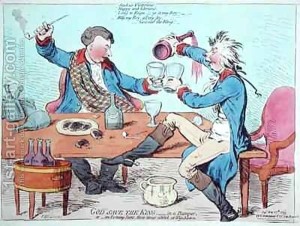Mr. Ephraim Hardcastle, Dry Salter and leading Old Fogey of the Regency has endeared himself to me. Assuming this isn’t really some impoverished, scandal-ridden fellow writing under an assumed identity, ala William Ireland, I have a fondness for the fellow. I worry about that because he says he’s 80 but his buddies many years older. Maybe he meant relatively many years.
I haven’t figured out yet why this book is titled Wine and Walnuts, but he’s also giving writing advice. Except let me back off a bit and say I find his remarks about First Person interesting. I suppose there’s a conceit there, the 3rd person thing.
Now, having said this much, I will endeavour to show how this marvellous faculty had birth —call me Egotist, if it be your pleasure, for I am of the old school, and save a world of circumlocution, (being too old now to alter) by persisting to pen my sage observations in the first person— I myself I, hating congenially with my ancient friends *, Baron M ***** s, and Mr. C * * * e, among the other ten thousand innovations, those of Him and We, as though in this mincing age every man must mince the matter of propria persona, and worry his brains to stand before the world after all, another Tom Fool, his own amanuensis, by writing as though mister some-one-else sat at his elbow and prompted every line. Well, gentle reader, I will endeavour to show thee how this faculty arose in my mind, how far it* has been indulged (if it have bounds), what have been its concomitants, and what an unceasing source of happiness it has been from early infancy to the present moment — and what a solace midst a multitude of cares; for its interest has “grown with my growth, strengthened with my strength,” and I may add, has lengthened, through God’s goodness, with my thread of life.*
Translation:
I’m too old to change. I’m giving you my advice in the first person. In fact, my buddies Baron M and Mr. C, also hate third person, among about 10 bazillion other things. [Insert eye roll here] Those youngsters today make everything more complicated and they couldn’t find themselves if they were alone in a closet. They can’t write “I did this!” Oh, no. They have to get all fancy, and say, “He did that.” As if we’re going to believe there’s someone sitting beside him telling him what to write. So, look, I’m just going to tell it to you straight.
*Nobody eats pies anymore. What’s the hell is up with that? Who needs those fancy tarts? I’m telling you, in my day, we had pie for dinner, and we were better for it. All my friends ate pie, just like I did, and none of need to wear glasses today! And we’re old!
You go Ephraim, with your pie and first person and not needing glasses. I agree with you. More pie!


